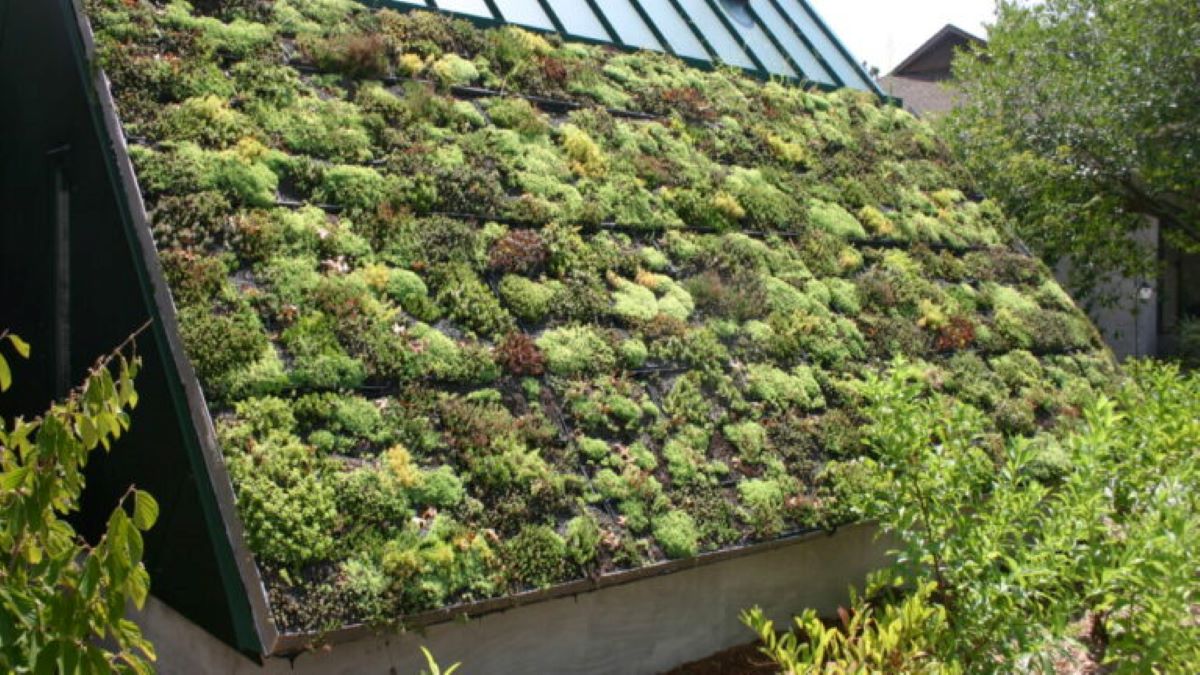
March 4, 2021
Imagine if all the houses and buildings in your city had green roofs. What would the city look like? Imagine that there is green space everywhere with the sounds of birds chirping and bees buzzing. This blog will be discussing the benefits of green roofs with a focus on its insulating property for buildings.
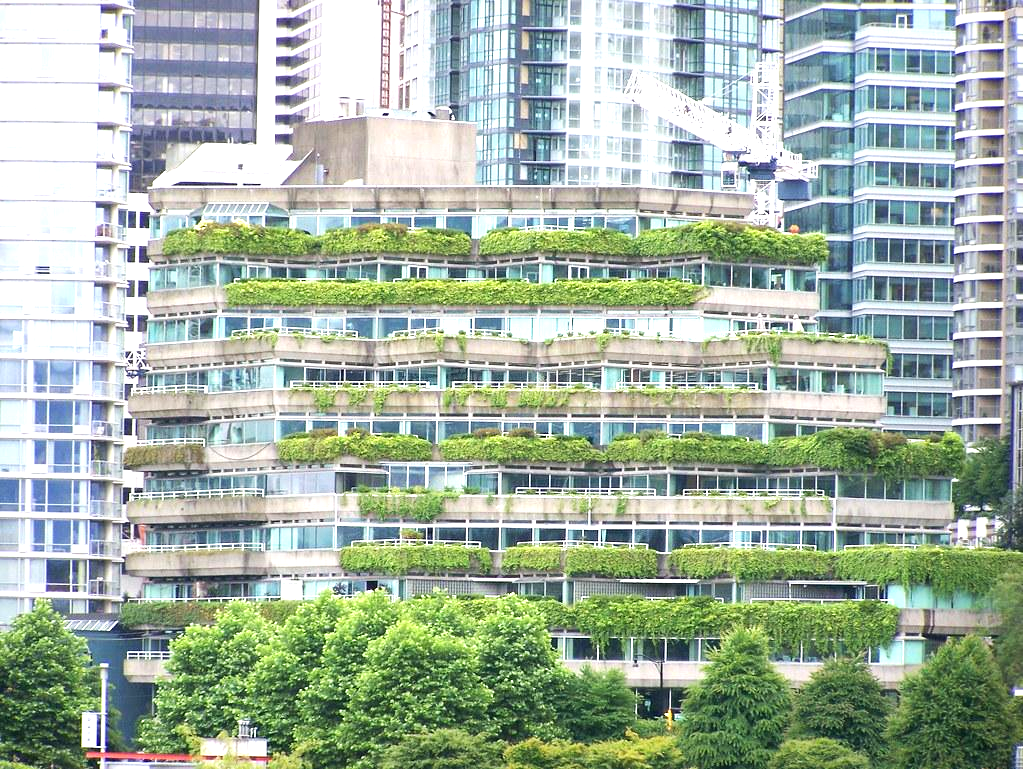
Figure 1. shows a building with green roofs located in Vancouver, BC.
A green roof is a man-made structure consisting of plants, its substrate and other necessary layers, laid on top of the roof membrane or integrated into it. It can be built on top of a building or a house. It is comparable in aesthetics to a small park or a garden, but it’s construction is significantly different because it is elevated, and therefore not connected to earth’s crust.
Additionally, a green roof’s maintenance needs are different from the maintenance needs of a traditional roof. Typical roofs are made out of asphalt, black tar or gravel (Dowdey, 2007). Green roofs are composed of vegetation, growing substrate, filter membrane, drainage layer, root barrier and waterproofing membrane (National Park Service, n.d.). These six layers can look different depending on the type of green roof. Green roofs are categorized into two main types: the extensive green roof and the intensive green roof.
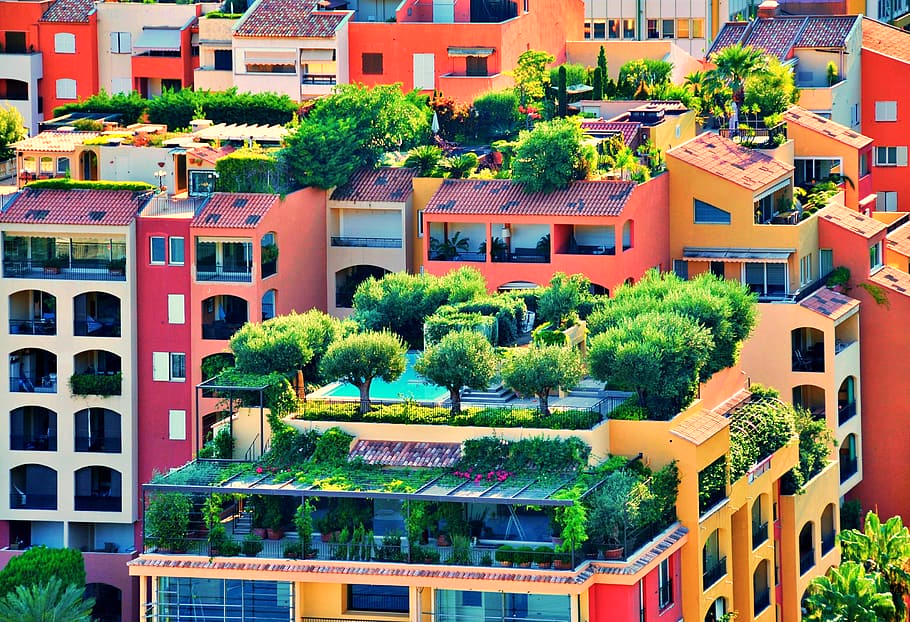
Figure 2. shows buildings with intensive green roofs.
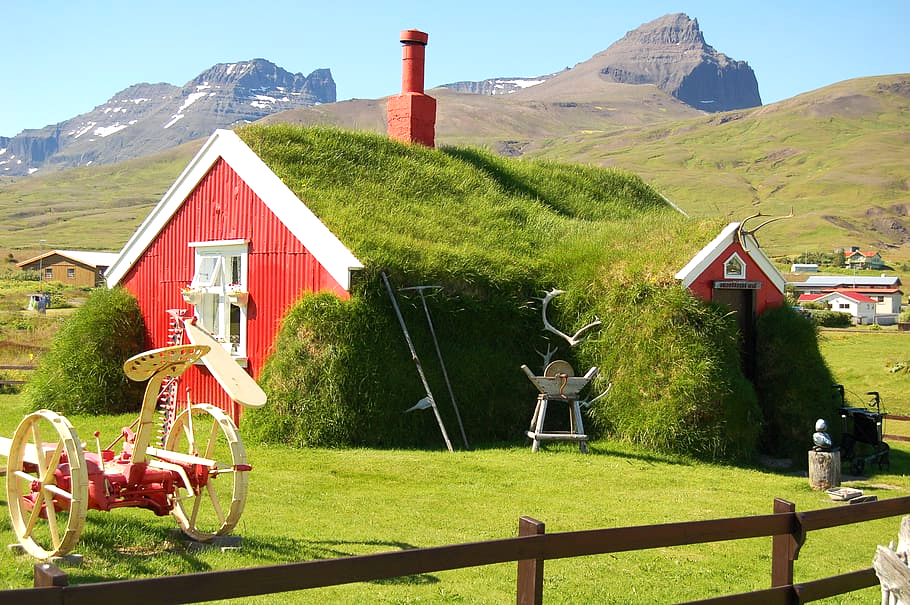
Figure 3. shows a house with an extensive green roof.
Image 4. shows that intensive green roofs are noticeably thicker than extensive green roofs. Intensive green roofs are deeper with relatively heavy growing substrate, while in comparison extensive green roofs are shallower with lighter growing substrate. The substrate is different from the soil found in parks and gardens. It is composed of mainly mineral aggregates, and only a small amount of organic soil (National Park Service, n.d.). Some green roofs have a mixture of characteristics from both types and are referred to as semi-intensive green roofs. From bottom to top, a green roof starts with a waterproofing layer because the roof membrane requires protection from storm water.
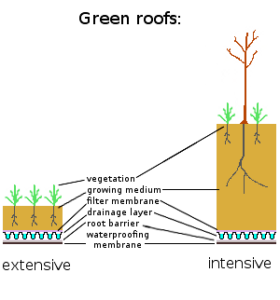
Figure 4. illustrates a diagram of green roof layers for the extensive and the intensive types.
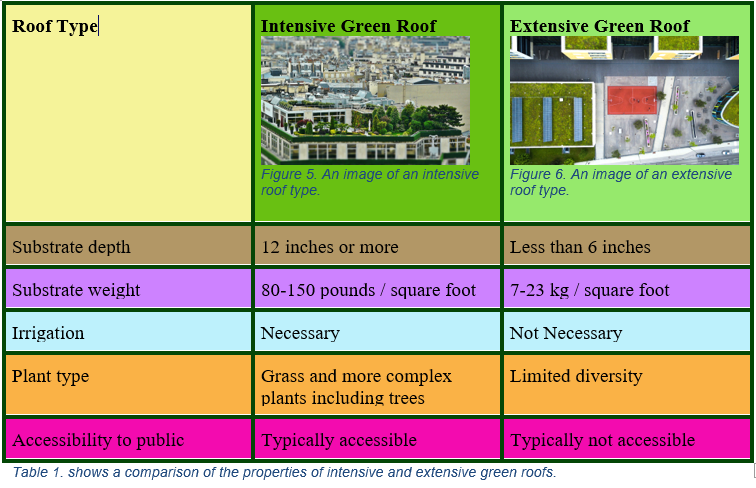
More often than not, green roofs are built in a continuous manner. However, there are also modular green roofs with combined plastic/metal trays of vegetation. The trays containing vegetation can be grown in a greenhouse then transferred to a green roof. It’s downside is a limited moisture flow between the trays; exacerbating wet-soil conditions from a heavy rainfall and dry-soil conditions from a lack of rainfall. This occurs since moisture does not have a large area of green roof substrate to spread within individual trays (National Park Service, n.d.).
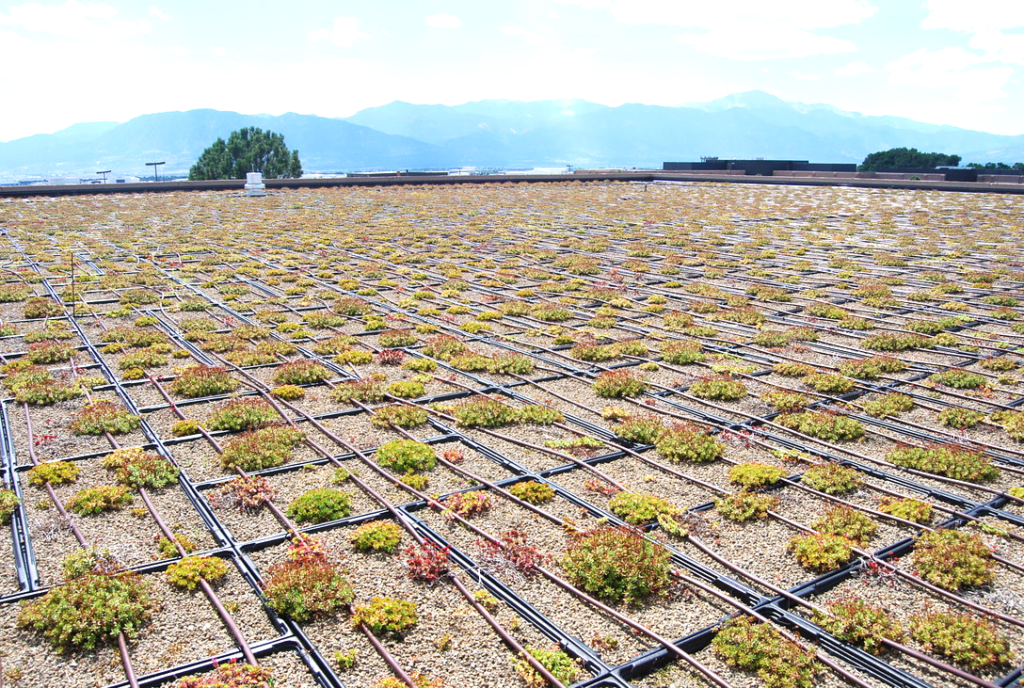
Figure 7. shows a modular green roof.
One proposed benefit of green roofs is that it can increase the thermal insulation of a building and there is evidence supporting this property. The results of a study conducted in 2011, in United States, indicated that extensive green roofs reduced heat flow through a building by an average of 13% in winter months and an average of 167% during the summer months, hence significantly increasing the thermal insulation of a building (K.L. Getter, 2011). This is the results of one experiment and there are many other experiments supporting the insulating property of green roofs with different percentage values.
There are 3 factors that make a green roof a good thermal insulator (Mert Eksi, 2017).
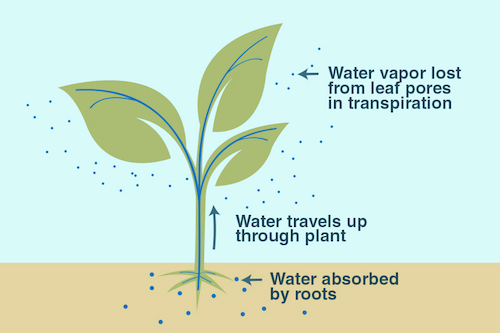
Figure 8. Illustrates the evapotranspiration process of a plant.
A green roof specialist has a choice in the type of the green roof to build, the selection of plants, the selection of materials that make up the growing substrate layer and the irrigation method. Educated selection of these components that make up a green roof will lead to the most successful results providing the maximum insulation for buildings and houses. For example, a green roof substrate that is less dense with air pockets provides better insulation compared to a more tightly packed substrate (Andrea Pianella, 2016). The thermal conductivity values of the materials that make up the growing substrate should also be taken into account.
In Summary, an intensive green roof type with a selection of plants that provide the maximum amount of shade canopy, and a growing substrate composed of materials with low thermal conductivity, packed with low density should provide the best insulation for a building.
Two case studies are considered below to explore what other choices in a green roof design can lead to higher thermal insulation.
Findings of Two Case Studies
Summary of Study 1:
Eksi et al. conducted an experiment to observe the thermal properties of intensive vs extensive green roofs. The entire green roof was 232 m2 in size located at the Molecular Plant Sciences building at the Michigan State University. It was sectioned off into 2 parts: shallow extensive roof with sedum plants and deep intensive roof with herbaceous plants. Both parts of the roof had identical green-roof layers with a difference in both the depth of substrate and the selection of plants. There was irrigation and fertilization present for each section. Michigan has a temperate climate with well-defined seasons; winters are cold with snowfall and summers are relatively hot. The experiment duration ranged from June 2013 to May 2014 and the results indicated that the extensive roof exhibited a larger range in temperature fluctuations. Since the intensive roof type has a deeper growing substrate it was expected to be more insulating, which was mostly the case. However during the winter months the extensive roof was better because the herbaceous plants held more snow coverage increasing the thickness of insulation. The researchers then predicted that the canopy shade and plant selection may be more important than the depth of the growing substrate for providing thermal insulation for buildings (Mert Eksi, 2017).
Summary of Study 2:
Hongming et al. tested out the thermal properties of the combinations of the most commonly used 5 soil substrates and the most commonly used 7 plant species for green roofs. There was a total of 35 cases stimulated. The heat flux and the amount of solar radiation absorbed were selected as the indicators for the thermal performance of the roof. The 5 soil substrates tested were: Avondale, Perlite, Clay, Cellar and Norlite. The 7 plant species tested were: Sedum Album, Sedum Sexangular, Sedum Hispanicum, Sedum Reflexum, Sedum Spurium D, Sedum Spurium O and mixed sedum specifies. The combination of the Sedum Album species with the Avondale substrate provided the best insulating value (Hongming He, 210).
It is well established that green roofs provide insulation benefits for buildings. It is important to note that the thermal findings of a green roof experiment is applicable for the specific region the experiment took place in. While there are some known generalities on how to build a green roof for different climate regions, a green roof specialist is highly encouraged to be consulted for each individual project. Building a highly efficient green roof requires expertise and knowledge on the climate and the ecology of where the roof will be located.
Benefits of Green Roofs
Aside from the increased thermal resistivity for buildings, there are many other benefits of having green roofs. The environmental benefits include an energy conservation by saving on fuel used for heating and cooling of buildings and an energy conservation by providing a natural water filtration process. Other environmental benefits include an increase in biodiversity, providing habitat corridors, reducing storm water runoff and reducing the urban heat island effect.
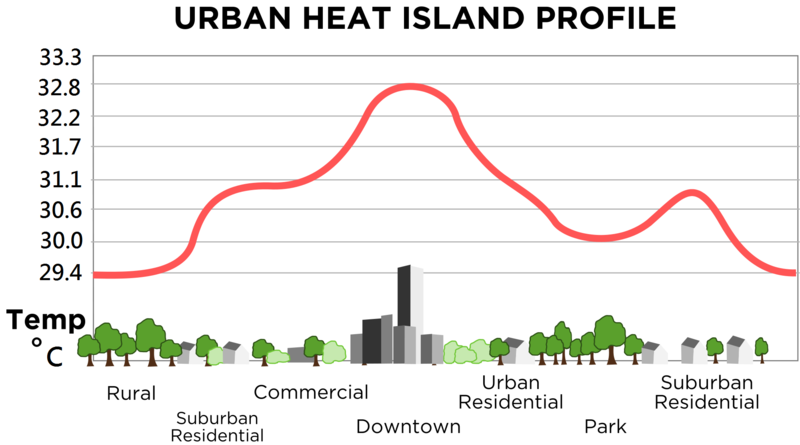
Figure 9. shows a graph of variations in temperature with a peak at downtown.
The addition of a green roof can increase the LEED rating of a building: a global Leadership in Energy and Environmental Design rating system.
Green roofs also have direct benefits for people. It provides a psychological feeling of well-being as a result of increasing green space and biodiversity. It can be used for agriculture and local job creation as it requires maintenance. It can also be used for educational purposes for biological sciences and architectural design. Green roofs provide increased insulation for buildings, counteract environmental stressors and provide direct benefits to humans.
Andrea Pianella, R. E. (2016, November 1). Steady-state and transient thermal measurements of green roof substrates. Energy and Buildings, 131, 123-132.
Diana E. Bowler, L. B.-A. (2010, September 13). Urban greening to cool towns and cities: a systematic review of the empirical evidence, Landscape Urban Plan. Landscape and Urban Planning, 97(3), 147-155.
Dowdey, S. (2007, July 11). What is a Green Roof ? . From How Stuff Works: https://science.howstuffworks.com/environmental/green-science/green-rooftop.html.
Hongming He, C. J. (210, September 29). Simulation of thermodynamic transmission in green roof ecosystem. Ecological Modelling, 221, 2949–2958.
K.L. Getter, D. R. (2011, December). Seasonal heat flux properties of an extensive green roof in a Midwestern U.S. climate, Energy Build. Energy and Buildings, 43, 3548–3557.
Mert Eksi, D. B. (2017, April 10). Effect of substrate depth, vegetation type, and season on green roof thermal properties. Energy and Buildings, 174-187.
National Park Service. (n.d.). What is a Green Roof ? From Technical Preservation Services: https://www.nps.gov/tps/sustainability/new-technology/green-roofs/define.html.
Image Sources:
Image 1. https://www.flickr.com/photos/nnecapa/2830785109
Image 2. https://www.pxfuel.com/en/free-photo-qgqzm
Image 4. https://commons.wikimedia.org/wiki/File:Intensive_extensive_green_roofs.png
Image 7. https://www.afspc.af.mil/News/Photos/igphoto/2000229325/
Image 8. https://climatekids.nasa.gov/heat-islands/
Image 9. https://commons.wikimedia.org/wiki/File:Urban_heat_island_(Celsius).png
Image 10. https://commons.wikimedia.org/wiki/File:Awesome_Green_Roof.jpg